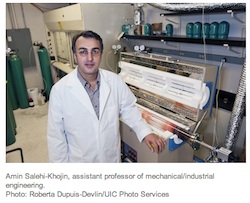University of Illinois at Chicago (UIC) scientists, under the lead of Amin Salehi-Khojin, UIC professor of mechanical and industrial engineering, have synthesized a catalyst that improves their system for converting waste carbon dioxide into syngas. The syngas is a percursor of gasoline and other energy-rich products and this recent achievement in the the research team’s process has brought the production of CO2 to energy closer to commercial viability. The study was published in the journal Nature Communications on July 30, 2014.
The research team developed a unique two-step catalytic process that uses molybdenum disulfide and an ionic liquid to “reduce,” or transfer electrons, to carbon dioxide in a chemical reaction. The new catalyst improves efficiency and lowers cost by replacing expensive metals like gold or silver in the reduction reaction.
 Mohammad Asadi, UIC graduate student and co-first author on the paper said the discovery is a big step toward industrialization. “With this catalyst, we can directly reduce carbon dioxide to syngas without the need for a secondary, expensive gasification process,” explained Asadi. In other chemical-reduction systems, he noted, the only reaction product is carbon monoxide. The new catalyst produces syngas, a mixture of carbon monoxide plus hydrogen.
Mohammad Asadi, UIC graduate student and co-first author on the paper said the discovery is a big step toward industrialization. “With this catalyst, we can directly reduce carbon dioxide to syngas without the need for a secondary, expensive gasification process,” explained Asadi. In other chemical-reduction systems, he noted, the only reaction product is carbon monoxide. The new catalyst produces syngas, a mixture of carbon monoxide plus hydrogen.
Salehi-Khojin, principal investigator on the study continued the explanation by noting the high density of loosely bound, energetic d-electrons in molybdenum disulfide facilitates charge transfer, driving the reduction of the carbon dioxide. “This is a very generous material,” said Salehi-Khojin. “We are able to produce a very stable reaction that can go on for hours.”
The proportion of carbon monoxide to hydrogen in the syngas produced in the reaction can also be easily manipulated using the new catalyst, said Salehi-Khojin.
“Our whole purpose is to move from laboratory experiments to real-world applications,” he said. “This is a real breakthrough that can take a waste gas — carbon dioxide — and use inexpensive catalysts to produce another source of energy at large-scale, while making a healthier environment.”







